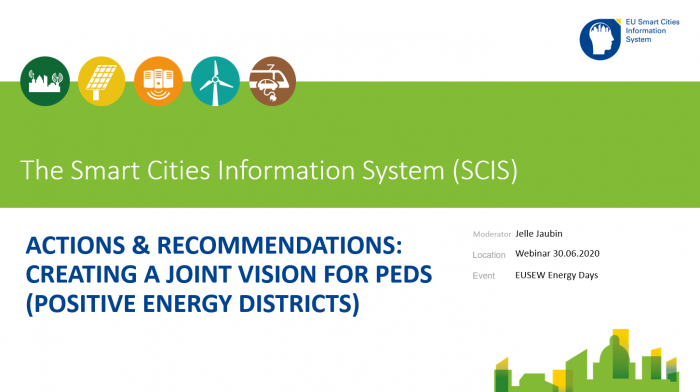
As part of this year’s EU Sustainable Energy Week’s extended programme, SCIS focused on Positive Energy Districts during its webinar ‘Actions & Recommendations: Creating a joint vision for PEDs’, moderated by Jelle Jaubin (SCIS consortium, VITO).
PEDs (Positive Energy Districts) are an important concept in both the EC’s Smart Cities & Communities (SCC) programmes and the Strategic Energy Technology Plan (SET plan). In the EC’s SCC Lighthouse programme, which has set PEDs as a formal standard in its recent calls, over 420 Million Euro are invested in 47 Lighthouse Cities and 67 Fellow Cities.
Two main lines of action are currently ongoing in this context: the refinement of the PED definition in order to arrive at a commonly accepted standard for PED implementation and the building of PEDs in on-the-ground projects such as under the EC SCC Lighthouse scheme. Given the current developments, a third factor is brought into the discussion: How can PEDs contribute to increased robustness against shocks and at the same time present specific opportunities for post-COVID recovery (Green Deal)?
The webinar started with an overview on different definitions and approaches of PEDs, presented by Han Vandevyvere (SCIS consortium, VITO). He looked ahead when carrying out that PEDs in Europe will be Urban Retrofit PEDs and describing the development from PED(Locks) over PED(istrict) to PEC(ity) and PER(egion) which will culminate in Renewable Energy Landscapes. Furthermore, he focused on the different boundaries of PEDs and the circumstance that all actors operating within them need to come together to define the PED; Therefore, he proposed to consider PED types according to the way the energy balance is achieved and thus provide for system flexibility and operational optimization potential in the way the PED is realized. Concluding, he outlined the main observed challenges and risks for PEDs (e.g. regulatory frameworks, vendor lock-in, and financing structures).
During the webinar’s second pitch, Christoph Gollner, from FFG (Österreichische Forschungsförderungsgesellschaft GmbH) presented the PED Framework, a transnational, intergovernmental R&I programme and joint initiative between SET Plan Action 3.2 and JPI Urban Europe which aims at having 100 Positive Energy Districts in Europe by 2025 that are synergistically connected to the energy system in Europe. Furthermore, he outlined the PED Framework and its operationalisation.
Thereafter, Rudy Rooth, Atelier’s local coordinator for the City of Amsterdam, provided insights into local challenges of the project that started of in late 2019. Among them are competing priorities like clean air, space limitations or climate justice. Moreover, he outlined the design of the so-called innovation ateliers with their focus energy transition. They are not only considered as vehicles for replication but will also culminate in self-sustained innovation platforms in the long run.
During the final pitch of the webinar, Marit Teigen Myrstad (Trondheim Municipality) and Klaus Livik (Powel) from +CityxChange and Samuli Rinne from MAKING-CITY provided insights to two field cases of their projects. The representatives from +CityxChange focused on regulations of the energy market and how these barriers could be overcome in order to becoming PED enablers. They pointed out a positive energy block’s dependency on regulations, politics, and technology. Finally, Samuli Rinne from MAKING-CITY outlined the 2050 vision for the City of Oulu, main challenges to be overcome along the way, and possible solutions for them.
After this final pitch, participants split up in two discussion rounds according their own preferences, dealing with:
- Discussion 1: Elaborating on the PED definition and certification work, feedback to the SET plan
- Discussion 2: Addressing challenges and barriers to building PEDs on the ground: recommendations, next steps, feedback to the related EU policy and regulatory frameworks
In a final round, conclusions of these fruitful discussions were drawn: Participants of the first discussion group agreed on the fact that the PED concept must remain approachable for people and that PEDs are evolutive as well as context sensitive. Concerning a possible certification process, one needs to assess to whom or to what the certification is aiming at. Moreover, there are strong arguments for virtual PEDs linked to LECs (Local Energy Communities) and/or DECs (Distributed Energy Communities). Lately, LEC legislation starts to appear and will lead to substantial improvements for realising (virtual) PEDs while good data hubs will be instrumental for achieving this goal. Participants of the second discussion group addressed amongst others the importance of experimenting regulations in current EU projects, the circumstance that the economic incentive is not in place for building owners – who expect a much more simplified regulation which they could understand and make use of – as the most urgent regulatory bottlenecks that need to be overcome to speed up the development of PEDs. The need for PED supporting regulation and policy is clear, but current ongoing regulation work would need more coordination and time. However, it is challenging to address all the policy making processes in an integrated and holistic manner. Furthermore, they argued that some investors don't see the long-term benefits of investing in PEDs. Therefore, regulation plays a very important role and could help to overcome this. Based on the feedback from the EIP-SCC matchmaking event, quite some investors are interested in making long term investments on infrastructures, PEDs included. In addition, both regulation and new innovative financing mechanisms and procurement are considered important in facilitating the breakthrough of PEDs.
If you did miss the actual webinar, you can find its recording here.
You can find the presentation slides here and the notes of the discussion rounds here.
